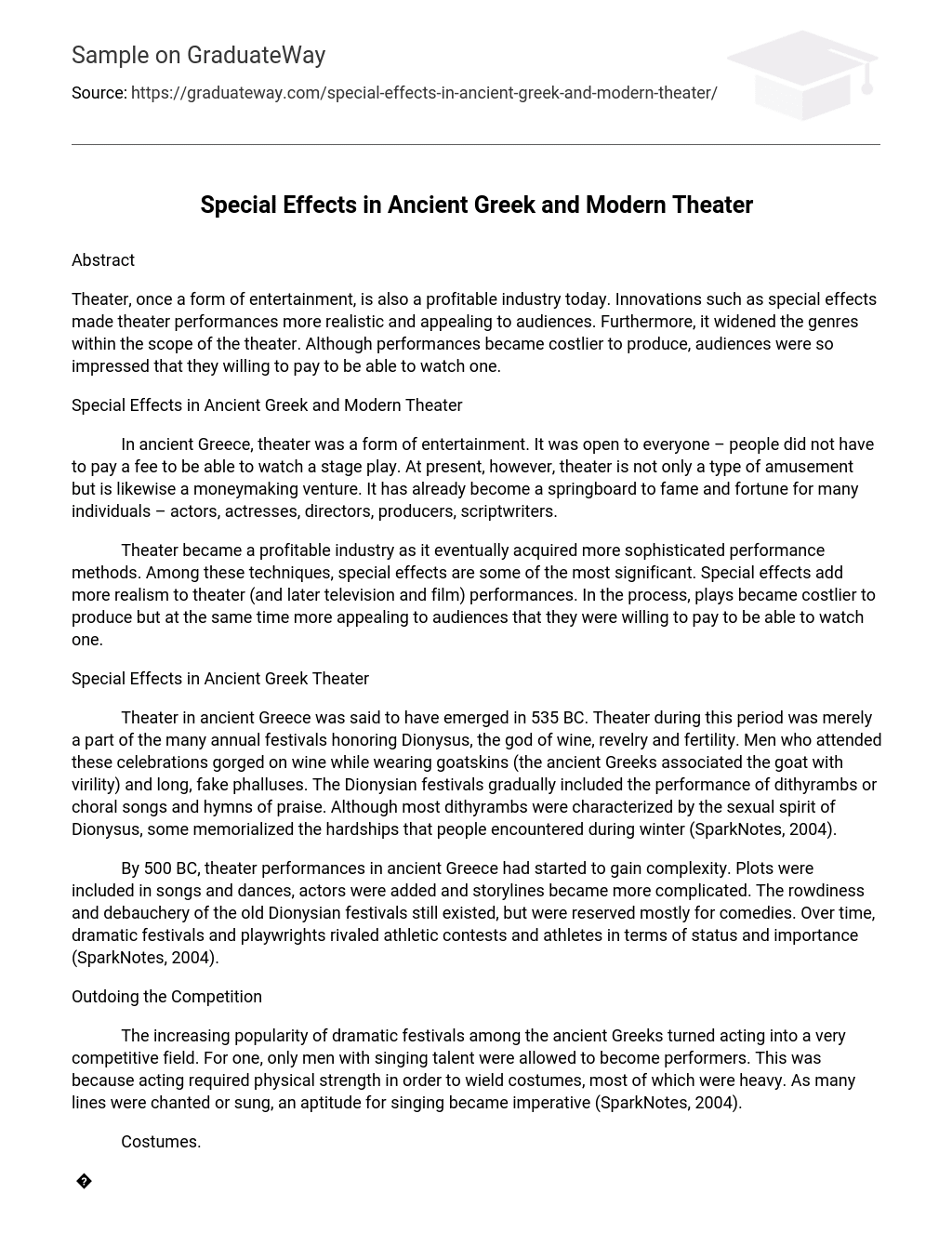Abstract
Theater, once a form of entertainment, is also a profitable industry today. Innovations such as special effects made theater performances more realistic and appealing to audiences. Furthermore, it widened the genres within the scope of the theater. Although performances became costlier to produce, audiences were so impressed that they willing to pay to be able to watch one.
Special Effects in Ancient Greek and Modern Theater
In ancient Greece, theater was a form of entertainment. It was open to everyone – people did not have to pay a fee to be able to watch a stage play. At present, however, theater is not only a type of amusement but is likewise a moneymaking venture. It has already become a springboard to fame and fortune for many individuals – actors, actresses, directors, producers, scriptwriters.
Theater became a profitable industry as it eventually acquired more sophisticated performance methods. Among these techniques, special effects are some of the most significant. Special effects add more realism to theater (and later television and film) performances. In the process, plays became costlier to produce but at the same time more appealing to audiences that they were willing to pay to be able to watch one.
Special Effects in Ancient Greek Theater
Theater in ancient Greece was said to have emerged in 535 BC. Theater during this period was merely a part of the many annual festivals honoring Dionysus, the god of wine, revelry and fertility. Men who attended these celebrations gorged on wine while wearing goatskins (the ancient Greeks associated the goat with virility) and long, fake phalluses. The Dionysian festivals gradually included the performance of dithyrambs or choral songs and hymns of praise. Although most dithyrambs were characterized by the sexual spirit of Dionysus, some memorialized the hardships that people encountered during winter (SparkNotes, 2004).
By 500 BC, theater performances in ancient Greece had started to gain complexity. Plots were included in songs and dances, actors were added and storylines became more complicated. The rowdiness and debauchery of the old Dionysian festivals still existed, but were reserved mostly for comedies. Over time, dramatic festivals and playwrights rivaled athletic contests and athletes in terms of status and importance (SparkNotes, 2004).
Outdoing the Competition
The increasing popularity of dramatic festivals among the ancient Greeks turned acting into a very competitive field. For one, only men with singing talent were allowed to become performers. This was because acting required physical strength in order to wield costumes, most of which were heavy. As many lines were chanted or sung, an aptitude for singing became imperative (SparkNotes, 2004).
Costumes.
In addition, they devised means which would make performances appear more realistic. Because they lacked the makeup being used today, actors portraying women sometimes rubbed the sediments from a cask of wine on their faces. The moods or traits of characters were revealed to audiences through large, heavy masks. These masks had small megaphones concealed in them so that the actors can project their words (SparkNotes, 2004).
Actors playing certain roles or professions wore specific costume colors and accessories. A play’s tragic hero, for instance, wore gloves and special platform shoes that elevated him above the other characters. The shoes would ensure that his fall from grace would have a more dramatic effect. Greek comedies that involved talking animals, meanwhile, required actors to wear animal features including furs, wings and tails (SparkNotes, 2004).
Levitation.
In scenes wherein it was necessary for gods and goddesses to appear from above, stagehands used ropes and pulleys to raise an actor to the level of the roof. This practice was said to have produced the idiom deus ex machina (“god from a machine”). In ancient Greece, the ability to elevate a human being through any means possible was already considered “miraculous.” As time passed by, however, deus ex machina assumed the connotation of excessive reliance on fate to solve problems (SparkNotes, 2004).
Special Effects in Modern Theater
The succeeding centuries saw an increased demand from theater audiences for stunning visual entertainment. As a result, the field of theatrical arts included other disciplines into its fold – architecture, fashion design, painting, interior decorating – in order to produce convincing scenic effects. Since the end of the 19th century, theater and all other scenic arts affiliated with it were burgeoning and socially acceptable industries. By the start of the 20th century, the practitioners of these disciplines in some countries had already achieved enough political clout to successfully unionize (Crabtree and Beudert, 1998).
Lighting and Painting
Carefully controlled lighting is one of the hallmarks of the modern theater. It has enabled the creation of effects such as cast shadows, moonlight, clouds passing in front of the moon, sunsets and varying times of the day or night (Crabtree and Beudert, 1998). The cyclorama – lifelike assemblages of paintings and three-dimensional decoration – is another remarkable innovation. It added more realism to theater performances by combining lifelike paintings with real objects like rocks, trees, carts, models and statues. The cyclorama is very useful especially in war scenes – battles are described in full detail, complete with severed limbs of dead soldiers (Crabtree and Beudert, 2005).
Conclusion
Special effects are some of the innovations that transformed the theater from being just a means of entertainment to a profitable enterprise. Because of special effects, performances became more convincing. Although plays became costlier to produce in the process, audiences were so impressed that they were willing to pay just to be able to watch one. Furthermore, special effects widened the genres within the scope of the theater. Theater nowadays can reproduce almost any scene or environment – forests, bustling cities, seashores and even battlegrounds.
References
Crabtree, S., & Beudert, P. (1998). Scenic Art for the Theatre: History, Tools and Techniques. Saint Louis: Focal Press.
Crabtree, S., & Beudert, P. (2005). Scenic Art for the Theatre: History, Tools and Techniques
(2nd ed.). New York: Elsevier.
SparkNotes. (2004). Greek Classics (SparkNotes Literature Guide). New York: Spark Educational Publishing.





